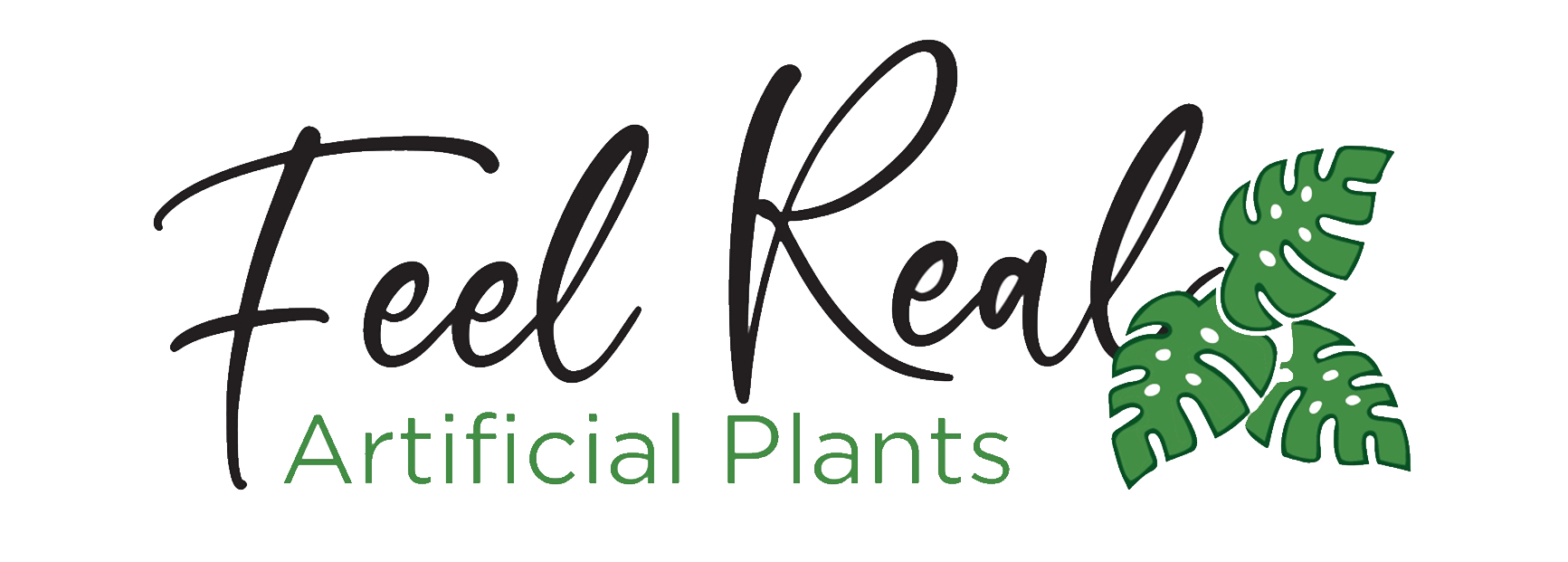Fiddle leaf fig trees are the new sweetheart of interior designers, home stylists and plant enthusiasts. They are tall, their leaves are lush and their silhouettes are sculptural, which immediately enhances the appearance of a room.
However as the owner of a real fiddle leaf fig will tell you, they are notoriously picky. They require proper light, humidity and care. Blow it, and you get browning leaves, drooping branches and a headache to maintain. That is where fake fiddle leaf figs come in. An artificial fig tree, well constructed, may supply all the grace and refinement of a natural one, without the watering-schedule, or the fear of vegetable desolation.
However not every faux fiddle fig is made the same. To make sure that you choose a realistic faux plant, you should know how to choose the best one among the manufacturers. We will take you through what to look at, what to ask, and what not to do.
Last Updated: 29th, July, 2025 | Estimated Reading Time: 7 minutes
Why Go for The Faux Fiddle Leaf Fig?
These are beautiful fiddle figs but they need more attention than most homes can give them. An example is that their growth can be stunted by not having bright indirect light in an indoor environment. Throw in pets, children, or dry indoor air, and you are usually dealing with a plant that is on life support.
A fake fiddle fig however is always in full bloom. It does not have to drop leaves, it does not need fertilizer, it does not need pruning. An example is when you are doing up a vacation apartment or a windowless office, you can have a faux tree that adds color and form that does not require maintenance.
These trees will complement any modern interior, as well as minimalist or even maximalist rooms that would require a bright, leafy touch. The beauty, durability and flexibility of design are all combined with apt construction.
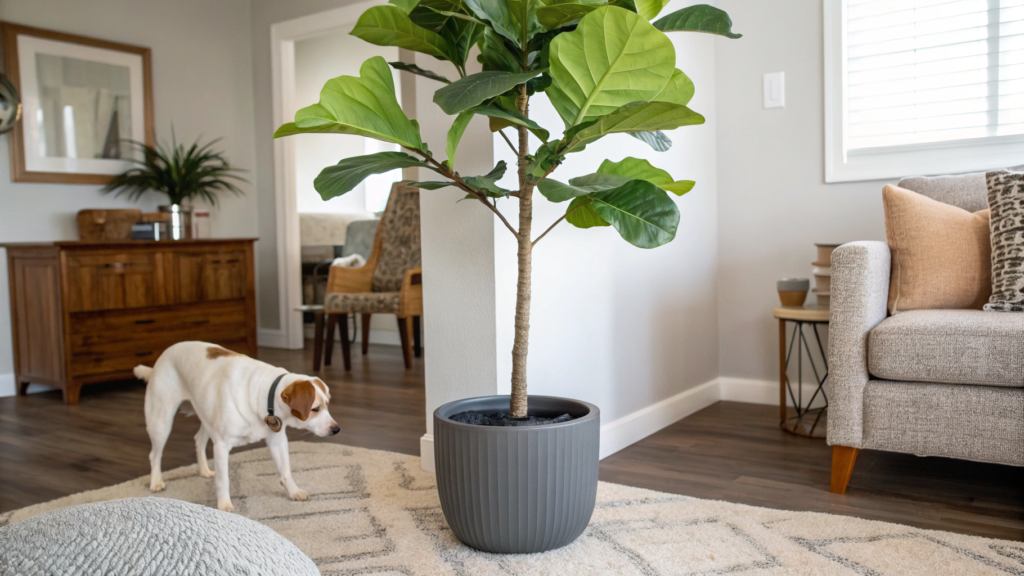
Realistic Faux Fiddle Leaf Fig: Key Features
It is important to know what distinguishes a high-quality faux fiddle leaf fig that looks like a real one and a standard fake before buying one. Here we will analyze design features that comprise the realistic look and durable quality.
Leaves
The leaves are the most outstanding characteristic of any fiddle leaf fig. Fakes can be created using material such as silk or polyethylene (PE) that tries to imitate the feel and appearance of natural leaves. PE leaves are also very veined with a mat finish as opposed to silk which leaves some slight variegation of color and a soft movement.
Avoid plastic leaves which are too shiny or uniform in shape as they are too cheap. These are clues, which indicate that you have a fake plant. The High-end faux figs are produced with various sized leaves, small color variations and rhythmic surface techniques that appear natural.
Trunk & Branch Architectures
Natural fiddle figs do not grow in perfect straight symmetry and neither should fake ones. When searching, find faux trees whose trunks are somewhat curvy and whose branches are spaced randomly. An example would be the manufacturer who would use preserved wood or hand-textured synthetic trunks to achieve this effect. The trunk too must have some texture, at least some slight ridge and a bark-like texture-not a plastic gleam. This makes the tree look more natural in your room, rather than a prop that is unnatural.
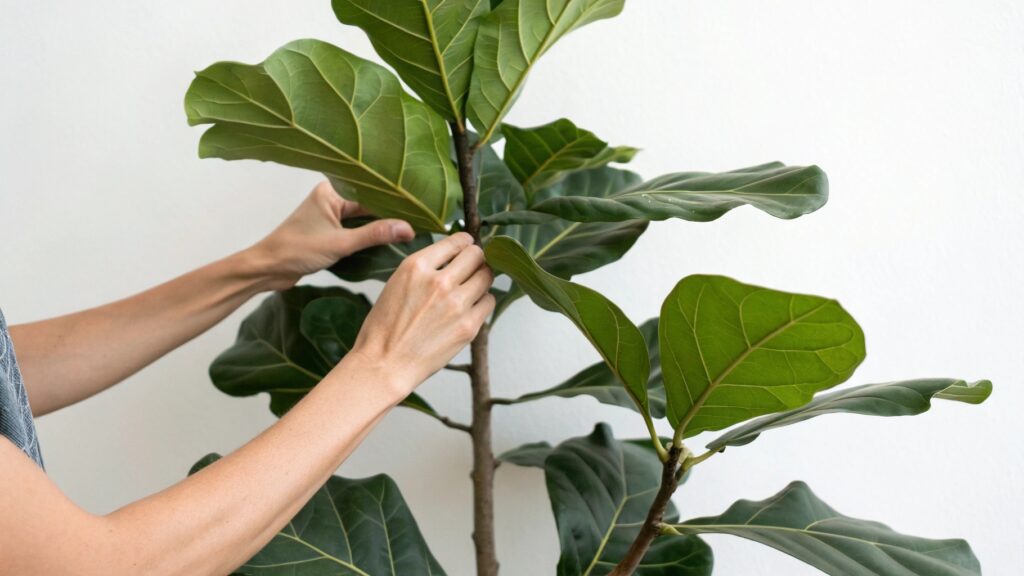
Base Stability
A shaky base is a huge no no. Good faux figs are supplied with weighted base of pot to avoid tipping off, particularly with taller designs. To illustrate, a tree that is going to be placed in a living room must be capable of firmly sitting in a ceramic or rattan planter without shaking.
To avoid the obtrusive nature of the pots, the manufacturers usually make them less conspicuous, and you are free to insert them in planters of your preference. The extra weight and intelligent sizing allow you to customise the appearance to your interior design and keep everything down to earth.
Material Knowledge and Their Role
To purchase intelligently, you need to know the materials of faux fiddle leaf figs and what they represent. Here, we will discuss the advantages and disadvantages of the most popular materials manufacturers utilize and study the way each of them influences appearance, durability, and performance.
PE (Polyethylene)
PE is the high-quality option when it comes to the artificial foliage that mimics the appearance and texture of natural plants. It is a flexible but strong plastic that can be formed into very complex shapes, and therefore very realistic veining of the leaves, natural curvature, and light color variation can be achieved.
PE leaves when used in faux fiddle leaf figs not only resemble the look but also give a pliable texture that resembles the rustling of actual leaves in the breeze. As an example, most of the good quality PE made fiddle leaf figs have bendable leaves that remain in the same shape after being styled, giving the homeowner the chance to design the tree to fit in his or her space.
The other significant strength of PE is its resistance to UV. This makes it an intelligent selection in places that are exposed or get indirect sunlight like next to a big window or under a skylight. Although other inferior materials may fade or crack with age, PE is colorfast and stable making the plant appear lucrative even after many years.
Also, PE is relatively simple to wash and endures well in places with varying temperatures and it is one of the most adaptable materials to indoor plants. Knowing these characteristics can make you determine which faux plant is worth the purchase and which can be more susceptible to damage and aesthetic degradation.
Silk
Silk leaves provide a smooth, sophisticated end that is perfect in low-traffic areas, and in places where the appearance is the main concern and not the durability. Silk leaves are also known to have a very fine texture and a smooth drape, which is why they are commonly used in interior design where the interior design is supposed to be sophisticated and warm.
Silk additions such as bedrooms, reading nooks or high end lounges are the perfect solution to viewing softer softness and subtle color shading. Silk can fairly resemble the flutter and matte sheen of real foliage unlike more stiff synthetic materials, and can be treated to coatings to enhance longevity and ease of cleaning.
For example, a silk fiddle fig in the corner of a master bedroom or close to the vintage armchair in the library can contribute to the ambiance to the level of peaceful and stylish. It is only worth mentioning though that silk is more susceptible to humidity and wear and thus it is not ideal when it comes to locations where there is moisture and those that are handled frequently.
Knowing how and in what context to apply faux plants made of silk will enable homeowners and designers to effectively incorporate texture and aesthetic quality to the decor without depreciating its durability.
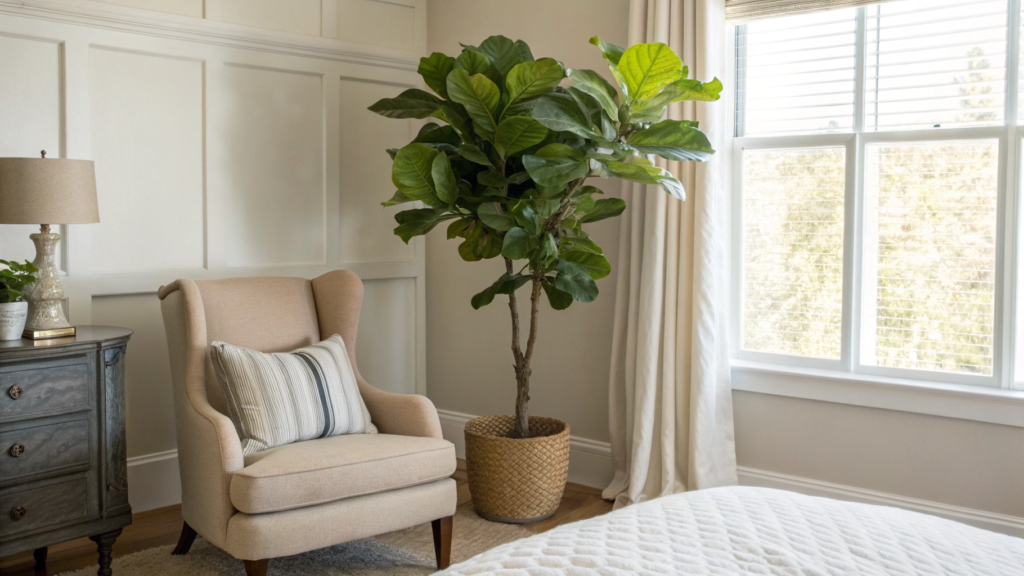
Artificial Blends
High-durability faux plants are often made by synthetic blends, and they are an ideal choice of busy homes with children, pets, or heavy foot traffic. These blends are manufactured out of superior, non-toxic plastics, which are designed to be fade, warp, and wear resistant, which means that they are safe and durable in daily use. They are also lightweight such that they can be moved around easily without the risk of them tipping or breaking.
The other major advantage of synthetic blends is that they are low-maintenance. They are easy to clean and cannot be easily dusted, and this makes them ideal in places such as hallways, playrooms, or kitchens. They are also structurally sound to hold up compact or vertical plant schemes, e.g., mini fiddle figs or corner plants, which gives the homeowner freedom of choice even in awkward or tight areas. The synthetic blends are a clever, common sense answer to those who appreciate durability and convenience.
What to Ask Your Faux Fiddle Fig Manufacturer?
After determining the visual and material characteristics of a fantastic faux fiddle leaf fig, you come to the assessment of the manufacturer itself. This part will guide you through the major questions you should ask and signs to consider when selecting a supplier who is able to provide quality, realism, and reliability.
Factory-Level Craftsmanship
Ask the manufacturer whether they are using high-resolution scans of botanical leaves and branches to model their own leaves and branches, a process that contributes an amazingly high degree of realism to the faux plants. This is done by scanning fine textures, vein pattern and bark form of actual foliage and transferring those scans into molds or computer models that are used in production.
The outcome is a foliage which exactly resembles its living prototype not only in outline but also in minor details, such as the transparency of the leaf or the furrows of the veins.
At FeelReal, we duplicate vein patterns through 3D scanning normally create more realistic designs that can be able to pass visual examination. This is especially applicable to faux fiddle leaf figs since they are usually set in well-lighted, conspicuous locations where visitors or customers can observe small details.
By incorporating these techniques, we gain a much clearer understanding of how visually realistic and durable the product will be in both professional and residential design settings.
Samples Testing and Inspection
Find out if the faux fiddle fig is UV-tested, fade-resistant, and has been treated to be dust repellent; these are important when it comes to the tree maintaining its beauty as time goes by. UV tests make sure that the materials employed will not discolor or diminish after being left under the sun.
The fade resistance is there to make sure that the bright green of the leaves is not going to fade with time, particularly in case the plant is placed near windows or skylights.
Before placing a bulk order, it’s critical to test key performance aspects of artificial plants. At FeelReal, we understand that every environment is different. That’s why we offer free samples for testing, allowing buyers to evaluate product performance before ordering. Our artificial plants are manufactured using commercial-grade materials and undergo rigorous in-house testing.
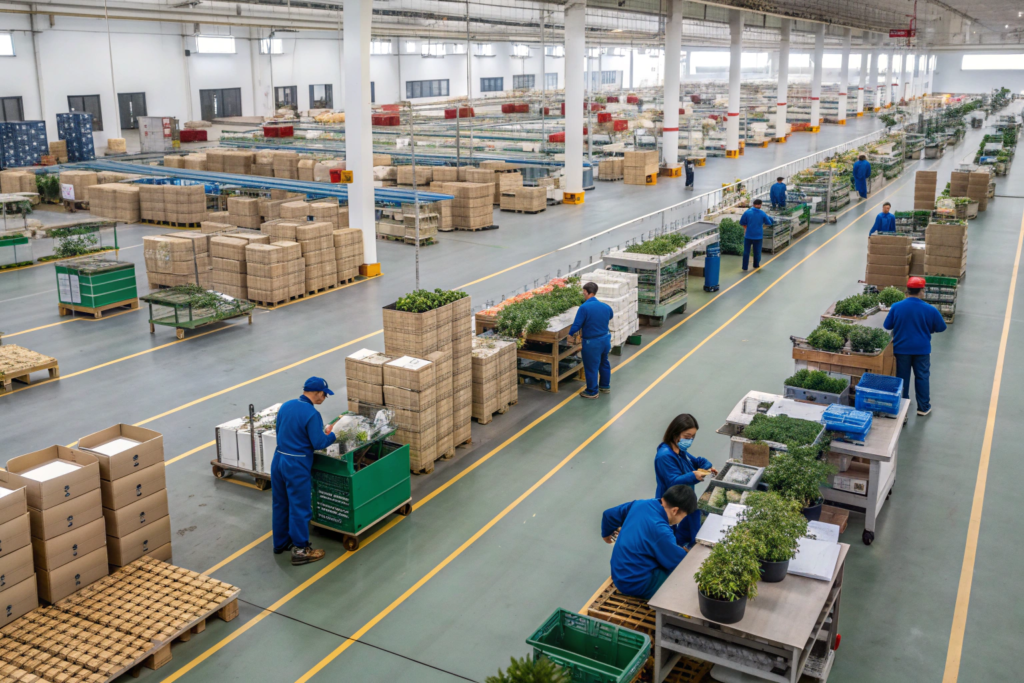
Options on Customization
Manufacturers who provide customization are able to control the amount of leaves, the shape of the trunk and the size of the base to suit a particular design. This comes in handy especially to clients who have special spatial or aesthetical needs.
For example, a commercial customer may ask to have a taller tree with a particular size of the pot and a smaller size of the foliage that would be suitable to the space and the appearance of the hotel lobby. In the case of residential clients, this can imply the choice of a thinner trunk in the case of tight corners or leaves that are wider to create more of an impact.
As a professional manufacturer, we offer tailored solutions based on real project needs. From adjusting leaf density, trunk thickness, and tree height to customizing pot size and base weight, our team ensures each faux fiddle fig fits the space and style—whether for a hotel lobby, office corner, or residential niche.
MOQ and Lead Time
When sourcing faux fiddle fig trees for large spaces or commercial projects, it’s essential to confirm the minimum order quantity (MOQ) and lead time in advance. At FeelReal, our MOQ is flexible depending on the design complexity, and we support low-volume trial orders to help clients test the market or meet small-scale project needs.
Lead times typically range from 2 to 8 weeks depending on order size, customization level, and shipping method. With over multiple production lines and efficient scheduling, we ensure reliable delivery even for urgent or large-volume orders.
Where to Place Fake Fiddle Leaf Figs at Home?
Now that you have an idea of how to assess quality and select the best materials, it is time to discuss where your faux fiddle leaf fig will work the most. In this section, we identify the best location in and around the house to place them to best create visual effect as well as supplement your interior design.
Living Rooms and Entrance Ways
Install tall artificial figs in corners, so as to create the vertical element and help to anchor the room. They are usually wide open spaces that can use dramatic but beautiful plants designs. Putting a tall fiddle fig by the sofa or next to an entry bench, for example, will create both structure and warmth, and so make the area seem more welcoming. A tall plant in an entryway serves as a visual reminder that brings the guests out of the world and into a more controlled interior space.
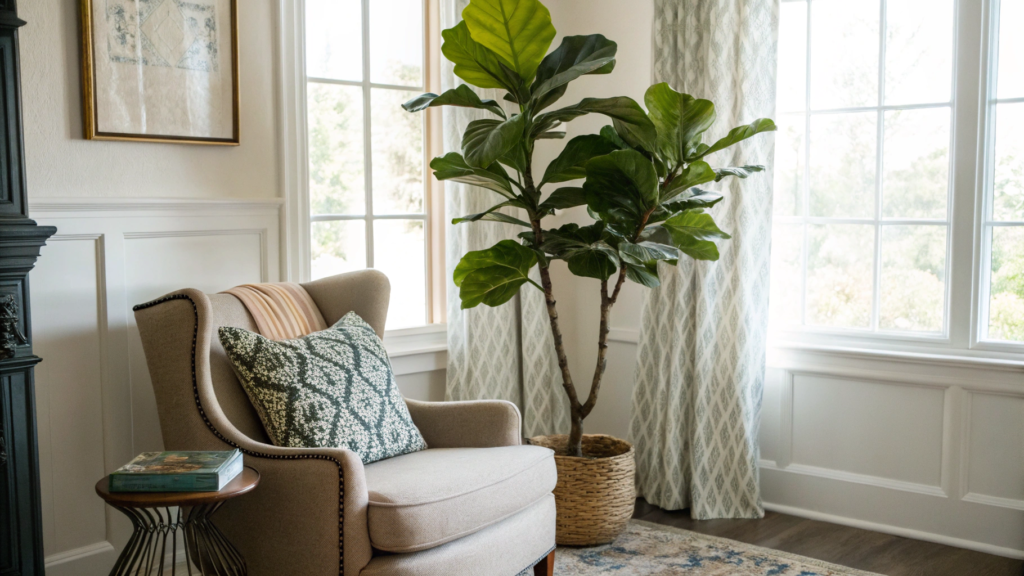
Kids Rooms and Reading Nooks
Faux fiddle figs come in smaller sizes and are perfect in personal areas where discretion and meekness are important. Such places are usually less illuminated and used to relax, so silk based figs can be a good fit as they are low maintenance and have a gentle feel. Putting a 3-foot silk fiddle fig tree in a pot made of ceramic next to a nightstand or a chair to read adds a touch of serenity, which can soften sharp edges and characterize the room without overpowering it.
Dining Rooms and Offices
A faux fiddle fig adds the natural contrast to an official scenario in ordered or functional areas, like in eating rooms and offices. When one is set beside a credenza, an office window or in the corner of the meeting room, it brings focus or relaxation with a hint of warmth, texture and organic content to a room. Medium-sized fiddle figs improve these areas and are realistic with realistic foliage and low height, which is not distracting.
Proper Tips to Care Faux Fiddle Leaf Fig:
Although faux fiddle leaf figs are much less demanding than real plants, they still must be taken care of to maintain beauty and prolong their life. To make your artificial fig tree look fresh and last many years, we suggest that you take a couple of easy care measures. These are some of the best maintenance habits to assist you in taking care of your faux fiddle leaf figs:
- Dust regularly: Use a soft micro fiber cloth or duster to rub off the dust that has accumulated. This is particularly vital in the case of silk leaves which would lose their realistic appearance when they accumulate dust.
- Wipe PE Leaves: In the case of plants that are created using polyethylene (PE), simply use a damp cloth to wipe the leaves so as to make them look fresh. Do not soak them, place them in abrasive cleaners.
- Look for shaping needs: After some time leaves or branches may require some slight shaping. FeelReal products have flexible stems, so that they can be repositioned without breakage.
- Avoid severe cleaners: Harsh cleaners such as ammonia, bleach and alcohol based cleaners should not be used because they have the ability to remove coatings and dull the finish of both silk and PE materials.
- Shield against direct heat: Not all faux fiddle figs are UV-resistant but, as much as possible, they should not be placed in direct contact with sources of heat, e.g. radiators or heating vents as this causes warping.
- Upright during moves: When you are moving or even remodelling your faux fig, ensure that you always store it in an upright position where it is safe to keep it so that its shape and structure is not compromised.
Mistakes to Avoid When Buying Fiddle Leaf Fig
Even the smartest consumers may sometimes forget some of the details when choosing the fake greenery. Knowing what not to do will assist you in selecting a plant that will make your space look better and remain there for years. These are some of the traps to watch out in purchasing a faux fiddle leaf fig:
- Too shiny leaves: Leaves that are too shiny will make an otherwise well-proportioned fake plant appear unnatural. The foliage should also wrap up with a natural and slightly textured/matte finish, and this is where the choice of a foliage with a soft, natural-like sheen can play an important role.
- Equal Branching: For the plants in nature, they do not grow symmetrically. Fake figs which have the same angles of branches or space can look unnatural. Make sure that you find designs that include irregularity and variation in branch placement.
- Lightweight Pots or Bases: Stability is important, particularly of plants that are tall. Tipping can be caused by a lightweight base or by a hollow base. Choose products that have a well balanced or weighted bottom so that your plant is grounded. This aspect is taken into account by many reliable manufacturers.
- No Warranty or Product Guarantee: A supplier that does not provide a guarantee or does not offer a return policy can indicate that the product will not have a long life or that it is not well crafted. Find companies that offer any kind of support, however little it may be, to have peace of mind.
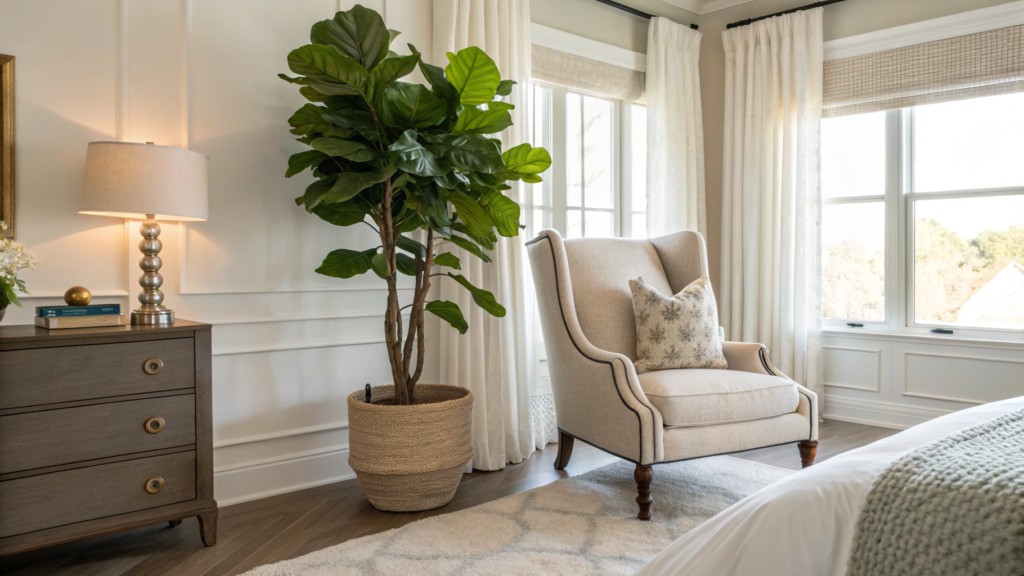
Conclusion:
Selecting the finest faux fiddle leaf fig needs understanding of both visibility and structure aspects. More than creating a greenery in your area of residence, the appropriate fake plant must resemble nature with detailed textures of leaves, naturally deformed and strong, well-crafted base. When spending money on something, it should be a quality piece, where there should be a balance between beauty and durability as well as considering how and where the plant will be used.
Be it a small apartment or a commercial building, you should always spend time to evaluate materials, workmanship, and credibility of manufacturers to come up with a more fulfilling purchase. When carefully chosen, a faux fiddle leaf fig can be another long-term design solution that adds a lot of warmth and sophistication to any interior. When deciding on the option, consider realistic appearance yet with practical features like UV protection or the possibility to adjust the size so that your plant looks good years down the line as well.
FAQs About Faux Fiddle Leaf Fig:
Q1: How can I tell a high quality faux fiddle leaf fig?
The details such as matte or textured leaves, uneven branch spacing, and more realistic surface of the trunk should be sought. Good materials such as PE or silk are indicators of good construction. Also, ensure that the pot is weighted and the manufacturer has details on UV resistance and the safety of the material.
Q2: Are faux fiddle leaf figs suitable to be around windows or in sun-filled rooms?
Yes, but it is better to select UV-resistant varieties. A standard faux fiddle leaf fig will fade and become brittle when exposed to direct sunlight from a window. High-quality versions are made with UV inhibitors infused directly into the foliage, which allows them to maintain their deep, vibrant green colour for years without damage.
Q3: Do faux plants pose any threat to pets and children?
High-quality faux plants are generally much safer for pets and children than many live houseplants, which can be toxic. The primary risk to consider is a choking hazard from small, detachable parts (like leaves or berries) on poorly made products or from small decorative pebbles in the pot. To ensure safety, always choose well-constructed plants from a reputable supplier that uses non-toxic materials, and opt for larger, non-swallowable stones for decoration.
Q4: How long does faux fiddle leaf figs usually last?
Given good treatment, Good faux fiddle figs may serve between 6 and 10 years. Frequent dusting, avoiding heat sources and handling them very carefully will make them last longer and appear fresh.
